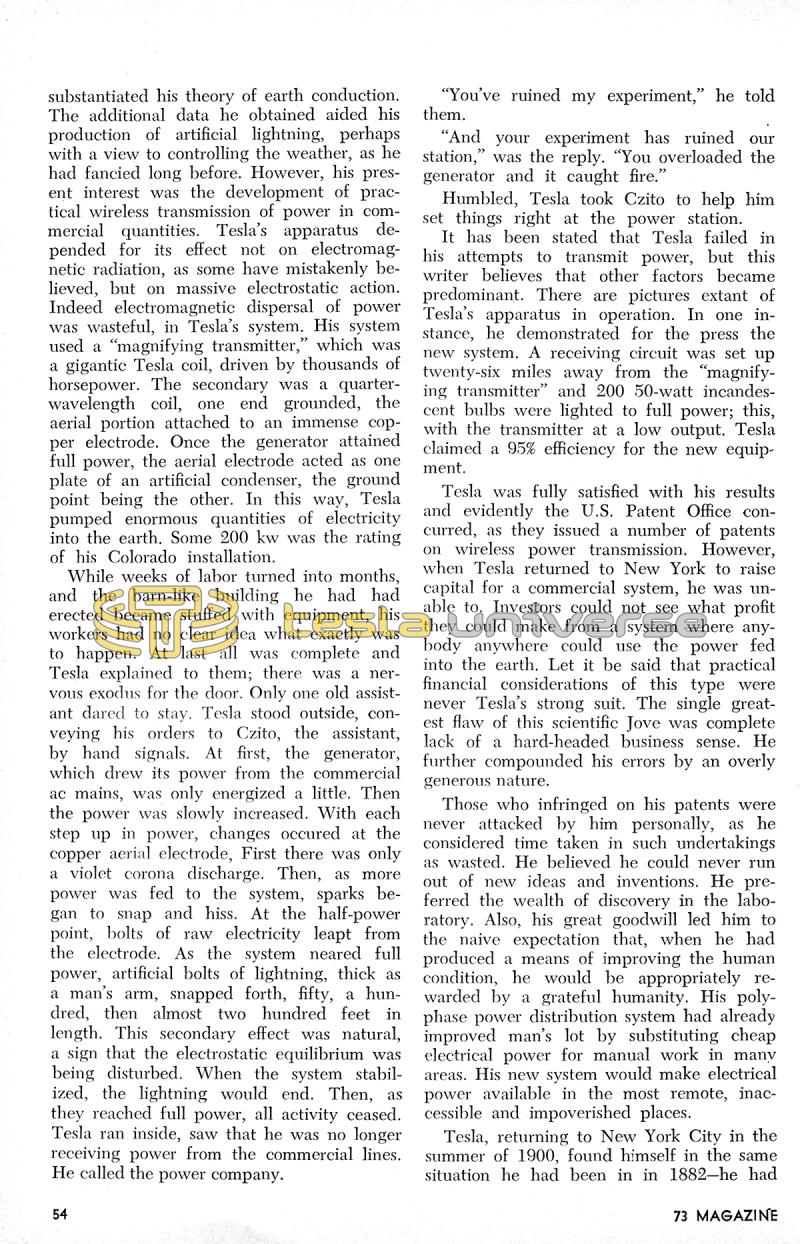
Nikola Tesla Articles
substantiated his theory of earth conduction. The additional data he obtained aided his production of artificial lightning, perhaps with a view to controlling the weather, as he had fancied long before. However, his present interest was the development of practical wireless transmission of power in commercial quantities. Tesla's apparatus depended for its effect not on electromagnetic radiation, as some have mistakenly believed, but on massive electrostatic action. Indeed electromagnetic dispersal of power was wasteful, in Tesla's system. His system used a "magnifying transmitter," which was a gigantic Tesla coil, driven by thousands of horsepower. The secondary was a quarter-wavelength coil, one end grounded, the aerial portion attached to an immense copper electrode. Once the generator attained full power, the aerial electrode acted as one plate of an artificial condenser, the ground point being the other. In this way, Tesla pumped enormous quantities of electricity into the earth. Some 200 kw was the rating of his Colorado installation.
While weeks of labor turned into months, and the barn-like building he had had erected became stuffed with equipment, his workers had no clear idea what exactly was to happen. At last all was complete and Tesla explained to them; there was a nervous exodus for the door. Only one old assistant dared to stay. Tesla stood outside, conveying his orders to Czito, the assistant, by hand signals. At first, the generator, which drew its power from the commercial ac mains, was only energized a little. Then the power was slowly increased. With each step up in power, changes occurred at the copper aerial electrode, First there was only a violet corona discharge. Then, as more power was fed to the system, sparks began to snap and hiss. At the half-power point, bolts of raw electricity leapt from the electrode. As the system neared full power, artificial bolts of lightning, thick as a man's arm, snapped forth, fifty, a hundred, then almost two hundred feet in length. This secondary effect was natural, a sign that the electrostatic equilibrium was being disturbed. When the system stabilized, the lightning would end. Then, as they reached full power, all activity ceased. Tesla ran inside, saw that he was no longer receiving power from the commercial lines. He called the power company.
"You've ruined my experiment," he told them.
"And your experiment has ruined our station," was the reply. "You overloaded the generator and it caught fire."
Humbled, Tesla took Czito to help him set things right at the power station.
It has been stated that Tesla failed in his attempts to transmit power, but this writer believes that other factors became predominant. There are pictures extant of Tesla's apparatus in operation. In one instance, he demonstrated for the press the new system. A receiving circuit was set up twenty-six miles away from the "magnifying transmitter" and 200 50-watt incandescent bulbs were lighted to full power; this, with the transmitter at a low output. Tesla claimed a 95% efficiency for the new equipment.
Tesla was fully satisfied with his results and evidently the U.S. Patent Office concurred, as they issued a number of patents on wireless transmission. However, power when Tesla returned to New York to raise capital for a commercial system, he was unable to. Investors could not see what profit they could make from a system where anybody anywhere could use the power fed into the earth. Let it be said that practical financial considerations of this type were never Tesla's strong suit. The single greatest flaw of this scientific Jove was complete lack of a hard-headed business sense. He further compounded his errors by an overly generous nature.
Those who infringed on his patents were never attacked by him personally, as he considered time taken in such undertakings as wasted. He believed he could never run out of new ideas and inventions. He preferred the wealth of discovery in the laboratory. Also, his great goodwill led him to the naive expectation that, when he had produced a means of improving the human condition, he would be appropriately rewarded by a grateful humanity. His polyphase power distribution system had already improved man's lot by substituting cheap electrical power for manual work in many areas. His new system would make electrical power available in the most remote, inaccessible and impoverished places.
Tesla, returning to New York City in the summer of 1900, found himself in the same situation he had been in 1882 - he had
